Strategic communications is at the heart of advocacy success —the art of communicating effectively with targeted audiences in order to move decision makers through the use of mainstream, social, new and paid media. Whether you are preparing a policy agenda at the state level or a budget ask at the local level, the Smart Chart from Spitfire Strategies is a go-to resource to help you get organized. Spitfire is a Washington, D.C. strategic communications firm dedicated to helping clients tackle the most critical social and environmental issues of our time.
Here’s my trial-by-fire story…
When I was at the California Alliance for Arts Education, I received a call from our lobbyist in early January 2006.
“Are you ready for this?” she asked. “Governor Schwarzenegger wants to put a line item in the state budget for arts education.”
“What?? How much?” I asked skeptically, thinking I knew all about budget crumbs and pats on the head from government.
Seventy-five million dollars. And they want the Alliance’s help to get it done.
You’re kidding, right?
She wasn’t kidding. Fast forward to eight months later, the budget was approved with ongoing funds of $105 million for arts education, and an additional one-time $500 million to be shared with physical education, to be allocated equitably across all districts on a per pupil basis. (Cue the trumpet fanfare.)
The point here is not the celebration of the largest budget allocation for arts education, ever (though that was pretty cool). The point lies in the communications lessons learned in the advocacy tsunami during those eight months. (Stay tuned for a later post on the critical role lobbyists play in arts education advocacy.)
After my deer-in-the-headlights moment, we all went to work. *
Remember, social and online media was in its infancy in 2006. Blackberrys still existed and iPhones weren’t that smart. “Click here to write your legislator” capability was in its infancy. The size of your list serve was a measure of effective communications. At one point in the campaign, I got a call from the Governor’s communications chief to tell us to be “ready to go to the mattresses.” (ICYMI: Godfather reference meaning “get ready to go to war.”) Talk about Old School. So, while tactical considerations for 2018 are a world apart from 2007, the concepts described below have enduring value.
A crash course in strategic communications with Spitfire Strategies was my entry point. Their Smart Chart was and is an invaluable tool in creating a communications plan for advocacy purposes. And it’s free. Now in its third iteration, Smart Chart 3.0 takes the reader by the hand in a clear and concise format, moving from vision to action, describing the decisional processes along the way. (Note: Spitfire does ask for your email address to receive the chart itself. You may download the booklet for free without providing your address. Also attached is the SmartChartBooklet as a PDF.)
Smart Chart features six major strategic decision steps, some with sub-sections:
- Program decisions—vision, objectives, decision makers
- Context—internal and external scan and positioning (framing)
- Strategic choices—audience, readiness, core concerns, theme, message, messengers
- Communications activities (tactics)
- Measurements of success
- Final reality check
I encourage you to take a look at Smart Chart to learn more. As I revisited the document, I’m reminded of some important lessons:
Duration. Concrete communications strategies for advocacy campaigns are fairly short term, usually no more than 24 months. These plans are different from (but not unrelated to) your organizational strategic plan.
Strategy drives tactics, not the other way around. It’s important to set out the Why (vision) before the How (activities/tactics).
An objective is not simply a restatement of the vision. If your vision is “all arts for all students,” an objective might be “within the next 12 months ensure the arts are included in the State’s ESSA plan.”
Audience refers to the people who can move your decision maker(s). The audience may be large or very targeted. In the case of the California budget item, the California State PTA with its 1 million members was a critical audience. As was the Entertainment Industry.
Positioning or framing the debate is key to getting a message out that will be heard. In the current education climate, the frame around “equity and access” is getting the most traction.
Types. Think of communication in three stages: sharing knowledge, building will, and reinforcing action. There are activities appropriate to each.
Message. In crafting an effective message, “it’s not what you want to tell them, it’s what they are willing to hear.” Test your message with your target audience.
MIGO. “My eyes glaze over” is an important shorthand reminder not to use jargon or acronyms in your message.
Messengers. The current media landscape demands multiple messenger voices and channels. You have to repeat something 10 times before someone believes it.
I hope this a helpful way for you to start the conversation with your colleagues. After all, you never know when you’ll be asked to go to the mattresses!
*State and national partners who contributed significant time, expertise and resources to the California arts education campaign in 2007:
Board members of the California Alliance for Arts Education
California professional arts teachers’ associations (CMEA, CAEA, CETA, CDEA)
Jennifer Hahn, now at Fenton Communications
NAMM members and Mary Luehrsen at the NAMM Foundation
National Association for Music Education (NAfME)
Robert Morrison, now at Quadrant Research
William and Flora Hewlett Foundation





